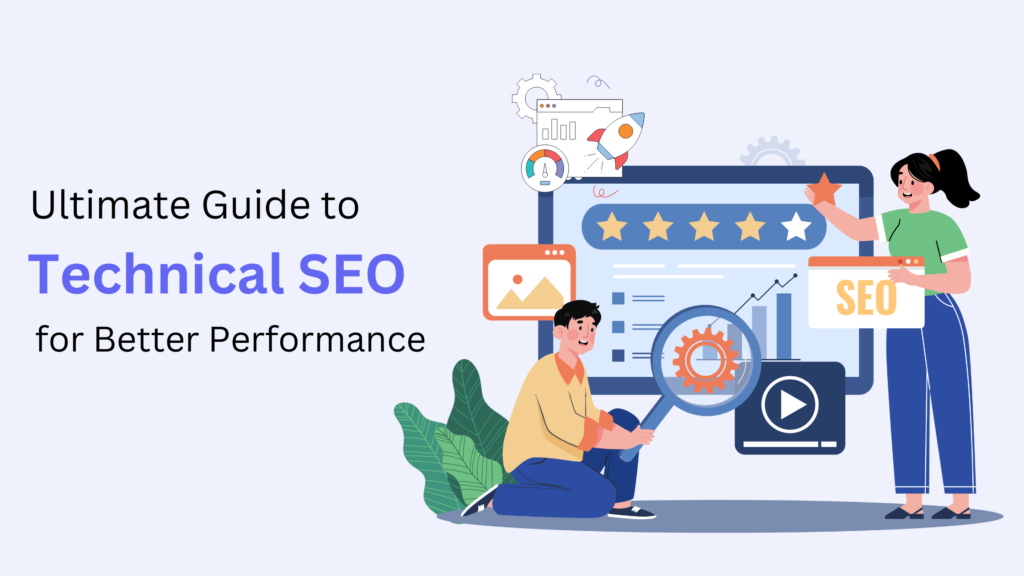Table of Contents
Technical SEO forms the backbone of your website’s search engine optimization. It focuses on optimizing your website’s infrastructure to make it accessible, crawlable, and indexable by search engines. A strong technical SEO foundation ensures that your site performs well, provides a seamless user experience, and ranks higher in search results.
In this guide, we’ll explore the critical components of technical SEO, common issues to watch for, and actionable strategies to optimize your website for better performance.
What Is Technical SEO?
Technical SEO involves optimizing the technical aspects of a website to ensure it meets search engine requirements. Unlike on-page or off-page SEO, technical SEO focuses on the underlying structure and functionality of your website.
It addresses issues like website speed, crawlability, mobile-friendliness, and security, all of which play a significant role in determining how search engines rank your site.
Why Is Technical SEO Important?
- Improves Crawlability: Search engines use bots to crawl websites. Technical SEO ensures these bots can access and understand your content.
- Enhances Indexability: Proper optimization ensures that search engines can index your pages correctly, making them eligible to appear in search results.
- Boosts User Experience: A fast, secure, and mobile-friendly website provides a better experience for users, reducing bounce rates.
- Supports Search Rankings: Websites with strong technical SEO tend to rank higher because they meet search engine requirements.
- Future-Proofs Your Website: Staying updated with technical SEO trends ensures your site remains competitive as search engine algorithms evolve.
Key Components of Technical SEO
1. Website Speed Optimization
Page speed is a crucial ranking factor for both desktop and mobile searches. Slow-loading websites lead to higher bounce rates and lower user satisfaction.
How to Improve Page Speed:
- Compress images to reduce file size.
- Enable browser caching to improve load times.
- Use a Content Delivery Network (CDN) to distribute content efficiently.
2. Mobile-Friendliness
With over 60% of searches conducted on mobile devices, having a mobile-friendly website is no longer optional.
How to Optimize for Mobile:
- Use responsive design that adapts to various screen sizes.
- Test your website on Google’s Mobile-Friendly Test tool.
- Ensure buttons and links are easy to tap on smaller screens.
3. HTTPS and Website Security
A secure website is essential for protecting user data and building trust. Google prioritizes secure sites in its rankings.
How to Secure Your Website:
- Install an SSL certificate to enable HTTPS.
- Regularly update plugins, themes, and software.
- Use strong passwords and enable two-factor authentication (2FA).
4. Crawlability
If search engines can’t crawl your site, your content won’t appear in search results.
How to Improve Crawlability:
- Create and submit an XML sitemap to search engines.
- Avoid using disallow directives in robots.txt for important pages.
- Fix broken links and redirect errors (e.g., 404 errors).
5. Core Web Vitals
Core Web Vitals are a set of metrics that measure user experience, focusing on:
- Largest Contentful Paint (LCP): Measures loading performance.
- First Input Delay (FID): Assesses interactivity.
- Cumulative Layout Shift (CLS): Evaluates visual stability.
How to Optimize Core Web Vitals:
- Minimize JavaScript and CSS blocking resources.
- Use lazy loading for images and videos.
- Optimize server response times.
6. Structured Data and Schema Markup
Structured data helps search engines understand the context of your content and display rich snippets in search results.
How to Implement Structured Data:
- Use tools like Google’s Structured Data Markup Helper.
- Add schema for reviews, FAQs, products, and local businesses.
- Test your markup with the Rich Results Test tool.
Common Technical SEO Issues to Avoid
- Duplicate Content: Identical content across multiple pages confuses search engines.
- Broken Links: These create a poor user experience and hinder crawlability.
- Slow Loading Times: Pages that take more than 3 seconds to load often see higher bounce rates.
- Non-Responsive Design: A website that isn’t mobile-friendly will struggle to rank on mobile searches.
- Incorrect Redirects: Misconfigured redirects can result in lost traffic.
How to Perform a Technical SEO Audit
Conducting a technical SEO audit helps identify and fix issues affecting your website’s performance. Here’s a step-by-step guide:
- Use Tools: Employ tools like Google Search Console, Screaming Frog, or Ahrefs for in-depth analysis.
- Check Page Speed: Use Google PageSpeed Insights to identify areas for improvement.
- Inspect Mobile Usability: Ensure your site is fully responsive and optimized for mobile users.
- Fix Errors: Resolve issues like broken links, redirect loops, and crawl errors.
- Optimize Metadata: Ensure all pages have unique and descriptive title tags and meta descriptions.
How SEO Booster UK Can Help with Technical SEO
At SEO Booster UK, we offer a comprehensive Technical SEO Package (€129.99) designed to enhance your website’s performance. Our services include:
- Full technical SEO audit
- Website speed optimization
- Mobile-friendliness analysis
- Core Web Vitals improvements
- Sitemap and robots.txt optimization
With our expertise, you can ensure your website meets all the technical requirements for higher rankings and better user experiences.
Conclusion
Technical SEO is an essential component of a successful online presence. By optimizing your website’s infrastructure, you ensure it is accessible, fast, and secure—key factors that improve rankings and user experience. If you’re ready to take your website performance to the next level, contact SEO Booster UK for expert technical SEO services. Let us handle the complexities so you can focus on growing your business.
